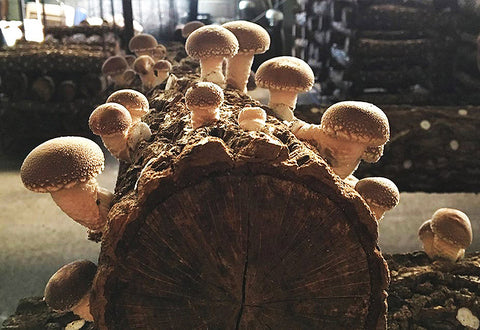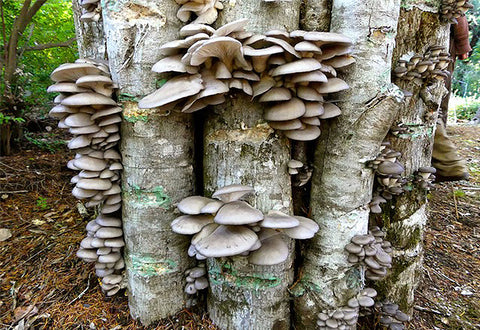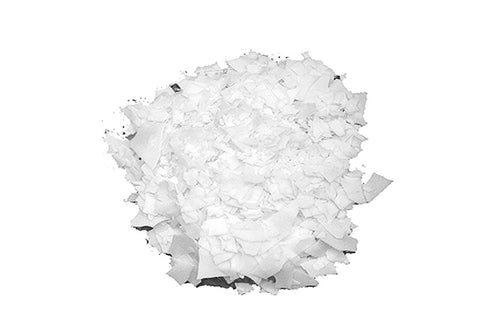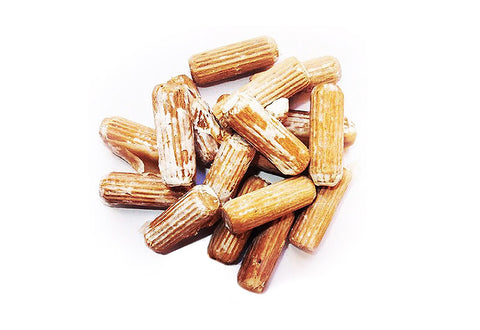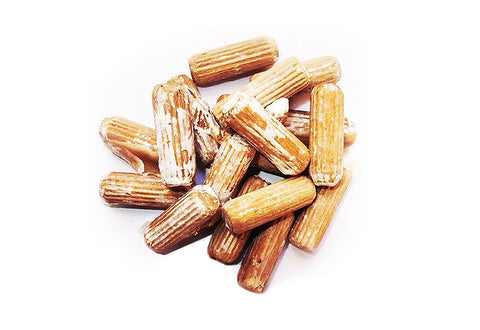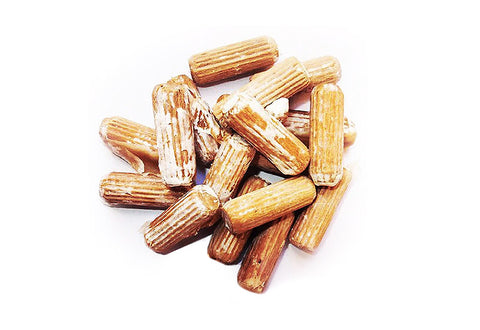Log cultivation is a fairly simple way to grow mushrooms in your garden. You can thus make use of your wood cuts while producing quality mushrooms over the long term.
It is a crop that requires some patience because the first mushrooms will take 12 to 18 months to appear... Then, a good log can produce mushrooms every year for 5 years. After inoculating the logs, the main work is essentially to maintain constant moisture on the logs.
You can grow different mushrooms in the same place, which will produce at different times of the year.
Here are the 3 points of this guide:
Choosing mushroom varieties and wood species
Each mushroom variety is unique: some will fruit at the end of summer like Pleurotus pulmonarius, and others will wait until winter like oyster mushrooms. Some varieties are more demanding than others regarding wood species.
Overall, all the varieties we sell on our site will grow on most hardwoods, but some combinations will yield better results and others should be avoided.
Choose your varieties with your wood species according to the table below:

Generally, it is better to avoid conifers because they contain substances that inhibit mycelium growth (antifungal). Some varieties are naturally adapted to conifers, such as Trametes versicolor or sulfur polypores. Their mycelia have therefore developed defense mechanisms or are capable of breaking down these antifungal molecules.
Pleurotus pulmonarius (summer oyster mushroom) can also grow on most pines, even on different varieties of firs. However, expect slightly less good results than on hardwoods.
Harvest Periods by Varieties

| Mushroom Variety | Jan | Feb | March | Apr | May | June | Jul | August | Sep | Oct | Nov | Dec |
|---|---|---|---|---|---|---|---|---|---|---|---|---|
| Shiitake | x | x | x | x | x | x | ||||||
| Yellow Oyster Mushroom | x | x | x | x | x | x | ||||||
| Lung Oyster Mushroom | x | x | x | x | x | x | x | |||||
| Oyster Mushroom | x | x | x | x | x | x | ||||||
| Nameko | x | x | x | x | ||||||||
| Enoki | x | x | x | x | x | |||||||
| Reishi | x | x | x | x | ||||||||
| Chaga | x | x | x | x | x | x | ||||||
| Lion's Mane | x | x | x | |||||||||
| Maitake | x | x | x | x |
Notes:
- Harvest periods may vary depending on local climatic conditions and cultivation methods.
- The "x" indicates the months when harvesting is generally possible.
- Indoor cultivated mushrooms can have different harvest cycles, as they are less affected by seasonal variations.

When to cut the wood?
Favor cutting wood during the dormant period, that is autumn-winter, before the sap rises. There are two truly optimal periods: in autumn when the leaves begin to change color and at the end of winter, just before the sap rises in the trees and the buds bloom. This way, the bark will hold longer on the trunk, and the results will generally be better.
That said, if you have wood at another time of the year, it will eventually be degraded by a fungus anyway (because fungi are the only organisms capable of decomposing the lignin in wood), so you might as well inoculate it with a mycelium that will produce mushrooms you can consume.
We recommend using fresh wood, which has been cut within the last 2-3 months maximum before inoculation. The optimal time is inoculation within 2 to 3 weeks following the cut. Depending on the species, it is sometimes recommended to wait 2 weeks before inoculation: partly because this allows time for some antifungal compounds to degrade, and partly because the wood cells will already be weakened, which will be more favorable to the mycelium.
But the longer you wait, the greater the risk that other fungi have already established themselves and will not leave room for the one you are going to inoculate in the log. Also, wood tends to dry out, mainly in summer and winter depending on the region. If the wood seems too dry to you, you can soak it for 12 to 24 hours in water before inoculation.
It is also recommended to use healthy wood, free from diseases and traces of other mycelia.
In the first weeks following inoculation, it is recommended to protect your logs from severe frost: indoor location, sheltered by a wall, cover with dead leaves or straw, blankets, tarps, etc. Covering the logs will also help limit drying out from wind and sun by providing an optimal mycelium environment for good mycelium development. The mycelium needs to breathe a little, so do not enclose your logs in 100% airtight tarps.
Wood essences
Hardwoods like oak, maple, or beech usually take longer to produce their first mushrooms, but they will also produce mushrooms for a longer time.
Conversely, birches or poplars will be quickly colonized by the mycelium and will fruit faster. But in the end, they will generally produce for fewer years and therefore fewer mushrooms.
There are always exceptions: oyster mushrooms will generally give better results on birch or poplar than on oak, but they will also give good results on beech.
The list of species is of course not exhaustive and should not prevent you from conducting your own experiments. We would be happy to read your feedback if you wish to share it with us by email: contact@lamycosphere.com
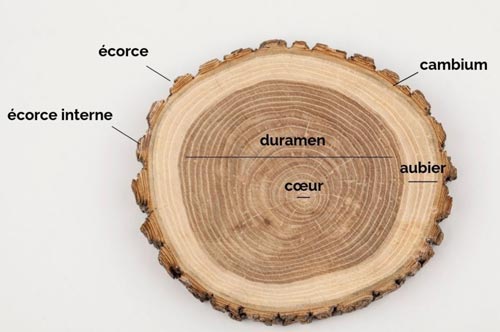
The diameters
We recommend a diameter ranging from 10 to 25 cm. Larger diameters will take longer to be colonized and therefore take more time to produce, but they will also yield over more years. They also resist droughts better than smaller diameters. The wood is generally cut into 1m long sections, which facilitates handling.
An exception regarding diameters: shiitakes. Shiitake mycelium mainly feeds on the sapwood of the wood, that is the layer of wood located towards the outside. Thus, for shiitakes, a smaller diameter ranging from 8 to 15 cm is recommended.
For diameters of 30cm and above, we rather recommend the totem technique: stacking sections 20-30cm high, with a 1cm layer of sawdust mycelium between each section. This technique is particularly suited for oyster mushrooms, lion's mane, and reishi.
The stumps of recently cut trees can also be inoculated, and produce over a period of 5 to 10 years. The entire root system contains a considerable amount of wood that can feed the mycelium long-term. The crucial period is within 4 to 8 weeks following inoculation because it is necessary to maintain sufficient moisture for the mycelium to establish deeply. Afterwards, the mycelium will have access to a large amount of carbon in the soil, while being able to absorb the moisture it needs from the soil.
Mycelium on ankles or on sawdust?
For small-scale log cultivation, dowel spawn is best suited. The only equipment needed is a drill, an 8 or 9 mm drill bit, a hammer, and possibly a brush. So it is within everyone's reach.
For larger scale production (100-200 logs), it becomes more interesting to work with sawdust spawn. The advantage of this type of spawn is its lower cost, but also a slightly faster colonization of the logs than with dowels. This only becomes interesting with the acquisition of certain specific tools such as a manual/automatic inoculator and drill bits adaptable to grinders. We also offer sawdust spawn by order in 3 or 5 kg bags; you can contact us by email for more information on this subject.
How long does the mycelium last?
Mycelium on plugs or sawdust keeps very well in the fridge. We recommend using it within 6 months of receipt. Ideally, use it more quickly of course, because the mycelium gradually loses vigor, and the risk of contamination increases over time.
Calculate the quantity of dowels
Here is a practical rule to quickly estimate your needs before using the detailed calculator.
Indicative estimate based on a standard staggered drilling pattern. Adjust with the calculator for an accurate result.
For a log of 1.2 m long and Ø 16 cm.
Log inoculation calculator for mushroom cultivation
Instructions for use :
1. Indicate the number of logs you will inoculate.
2. Enter the diameter of your logs.
3. Enter the length of your logs.
4. Choose the spacing to use between each inoculation point within the rows.
5. Specify the spacing to use between each row of inoculation points.
6. Check your results above the photos below.

Seeding methods (inoculation)

The technique of the traditional log
- Use an 8 or 9 mm wood drill bit for inoculation with plugs or 12 mm for inoculation with mycelium on sawdust. Make holes 3 to 4 cm deep all around the log. The holes should be slightly deeper than the plugs. Make staggered holes about every 10 cm, with a spacing of approximately 8 cm between rows.
- Insert the plugs into the holes, using a hammer if necessary. The plugs should not protrude from the holes. For inoculation with mycelium on sawdust, a suitable tool is recommended.
- Cover with wax. The wax serves to protect the mycelium from drying out, as well as from insects and diseases. Alternatively, you can also use paraffin, cheese wax, or green clay. This is particularly important for mycelium on sawdust. For inoculation with plugs, it is possible to do without it provided you take more precautions against the drying of the logs after inoculation.
- Be patient. Depending on the varieties, wood species, and diameters, you will need to wait between 6 to 18 months. Place your logs in a shaded area sheltered from the wind. Avoid direct contact with the ground, which could bring small insects and contamination from soil fungi. You can, for example, place them on a pallet covered with a tarp or a cloth. In case of heat, occasionally pour a watering can of water over the logs to prevent them from drying out. For this first incubation phase, the logs can be stacked. After 3 to 6 months, you can space them out. For oyster mushrooms, maitake, and reishi, we recommend burying them one-third into the soil so they can absorb water from the ground. Oyster mushrooms generally appear at the end of autumn and the beginning of spring.
- Harvest and enjoy your production. A log made under good conditions can produce mushrooms for 3 to 5 years.
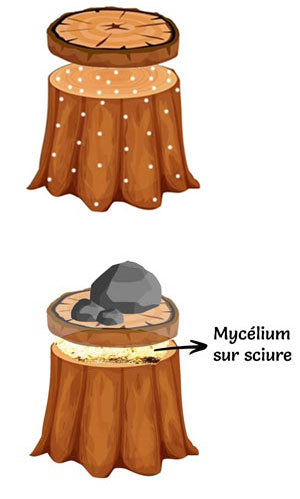
The stump technique
Stumps take longer to colonize and produce than logs, but can produce mushrooms for nearly 10 years. The stumps must have been cut recently. They should also be located in a shaded and humid place to avoid dryness. If possible, cut the stump 20 to 40 cm above the ground to facilitate inoculation.
To prevent regrowth or shoots, you can "girdle the trunk at the base" by removing a 3-4 cm strip of bark at the lowest point near the ground.
Stumps can be inoculated with mycelium on dowels or on sawdust (see images)
- Use an 8 or 9 mm wood drill bit for inoculation with dowels or 12 mm for inoculation with mycelium on sawdust. Make holes 3 to 4 cm deep all around the stump. The holes should be slightly deeper than the dowels. Make staggered holes every 5 to 10 cm.
- Insert the dowels into the holes, using a hammer if necessary. The dowels should not protrude from the holes.
- Cover with wax. Wax is used to protect the mycelium from drying out, as well as from insects and diseases. Alternatively, you can also use paraffin, cheese wax, or green clay. This is especially important for mycelium on sawdust. For inoculation with dowels, it is possible to do without it provided you take extra care to prevent the logs from drying out after inoculation.
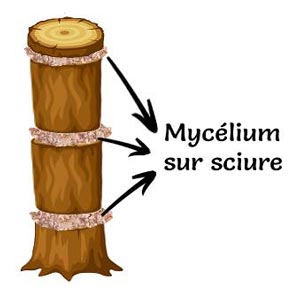
The technique of the totem
The totem technique is particularly suitable for sections with a large diameter (>20 cm). The wood is cut into sections 20 to 30 cm long, stacked in a sandwich with a layer of mycelium between each section. This technique is especially suited for oyster mushrooms, lion’s manes, and reishis.
A 3 kg bag of sawdust mycelium allows inoculating about 4 to 6 stacked wood sections of 30 cm diameter.
- Cut 3 sections of 20 to 50 cm in length. Also count on a cap of about 5 cm that will go on top.
- Place the whole setup in a shaded and humid location.
- The base of the totem can be a stump. Otherwise, start by placing a layer of brown cardboard on the ground. Put a first layer of 2 to 3 cm of sawdust mycelium. Then build your totem with a layer of mycelium between each section, finishing with a 5 cm cap. A perforated bag can be used to cover the entire totem. This will allow optimal mycelium development, protected from dryness. Alternatively, you can also cover the edges with wax.
- Be attentive during the first 6 months to ensure the mycelium does not dry out. You can remove the bag when you see well-established mycelium on the logs.
- Once your logs are well colonized (6 to 12 months), the totem can be left as is for fruiting. You can also divide it so that each section is in contact with the soil to limit drying out.
For certain varieties like maitake, namekos, or reishis, it is recommended to partially bury the logs in the soil after colonization. This will help maintain constant humidity, but also stimulate fruiting through contact with soil bacteria.
How to see if my logs are well colonized?
You can look at one of the ends of the wood. You should see mycelium (small white filaments). The mycelium does not always cover the entire wood and that is not a problem. At first, there may be small surface molds developing on the edges; they feed on the sap residues coming out of the wood. If the end has dried (which should be avoided), the mycelium may not be visible. You can then cut a part to see the mycelium inside the wood.
Maintenance and harvesting of mushrooms
The main risk of this crop is drought. We therefore recommend covering the logs with a tarp or a veil if necessary to maintain the moisture of the logs, especially during the incubation period.
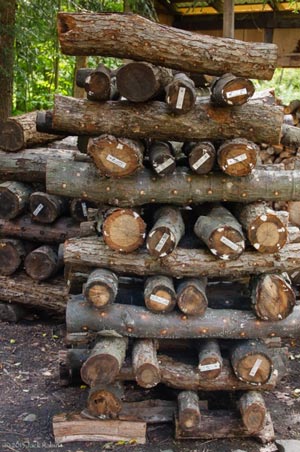
Place your logs in a naturally humid location: undergrowth, bushes, etc. Initially, avoid placing the log in direct contact with the ground to prevent other native mushrooms from competing with our mycelium. You can place your logs on a pallet if you have many, or simply on small pieces of wood that will elevate your logs.
In case of dryness, occasional watering may be necessary. Conversely, be careful not to keep them soaked or damp for too long, as the mycelium needs to breathe.
On a professional scale, you can use a shade cloth and sprinklers to maintain high humidity during mushroom growth.
To thoroughly moisten your logs, the ideal is to soak them for 12 to 24 hours in a basin of water.
After the incubation period (6 to 12 months), it is necessary to space out the logs. This allows more air to circulate and provides room for good mushroom development, and also makes harvesting easier.
Mushrooms tend to grow naturally after cool and humid periods. This can be encouraged by soaking the logs in a basin of cold water for 12 to 24 hours (avoid tap water that contains chlorine, or let the water sit for a few hours beforehand). This works particularly well for shiitake mushrooms. Note that you should allow at least 1 month of rest between each harvest.
How long should you wait before harvesting the mushrooms?
The wood colonization period (incubation) varies according to mushroom varieties, wood species, section diameters, and temperature. The duration can thus range between 6 months and 2 years.
Oyster mushrooms are a faster and more aggressive variety than most other cultivated varieties. Thus, logs inoculated at the end of winter can already produce mushrooms by the first autumn. For shiitake, for example, it will rather take about 18 months. So don't despair if you don't see your beautiful mushrooms in the first year.
Most mushrooms need coolness and humidity to grow. If these conditions are not met, they will not grow.
The quantity of mushrooms depends on many factors, so it is impossible to give an exact figure. Generally, between 10 and 20% of the log's weight in fresh mushrooms harvested over the entire cultivation cycle is expected.Other readings
To go further in the readings, you can download the following two PDFs:

